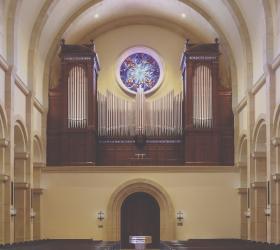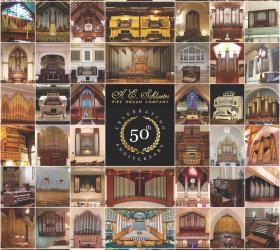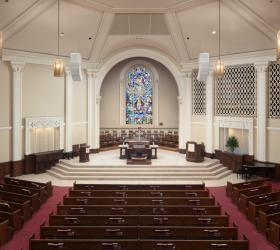
Orgues Létourneau,
St-Hyacinthe, Québec, Canada
The Sabbatino Family Memorial Pipe Organ, St. Joseph’s Church in Greenwich Village, New York, New York
From the organist and director of music
For more than 187 years, the congregation of St. Joseph’s Church has worshipped and praised God in the sacred liturgy through prayer and song. Founded in 1829, St. Joseph’s Parish was the sixth to be established among those still in existence in the Archdiocese of New York. The cornerstone of the present structure was laid on June 10, 1833, “at the corner of Barrow Street and Sixth Avenue” and allows St. Joseph’s Church the distinction of being the oldest Catholic church edifice in Manhattan and perhaps the entire archdiocese.
Dedicated on Sunday, March 16, 1834, St. Joseph’s Church is today an integral part of the vibrant neighborhoods of Greenwich Village, Chelsea, and Tribeca. In 2003, the Archdiocese of New York invited the Order of Preachers (the “Dominicans”) to care for the combined ministries of both the neighborhood residents and the students and faculty of New York University. Today, four friars serve these constituents of St. Joseph’s Church in Greenwich Village.
The organ at St. Joseph’s has always been an important element of the music program. Earlier instruments by Henry Erben (1836) and Aeolian-Skinner (1952) had been in use prior to the installation of Létourneau’s Opus 128. This new organ, built in Saint-Hyacinthe, Québec, Canada, has mechanical key action as well as electric stop action and contains 31 stops and 39 ranks over the three manuals and pedal.
Known as the Sabbatino Family Memorial Organ, the instrument and its installation were made possible through a bequest from Clare C. Sabbatino, a lifelong resident of Greenwich Village and faithful parishioner of St. Joseph’s Church. Clare had a deep appreciation for music—her father and uncle were both musicians with the New York Philharmonic—and her gift in honor and memory of her entire family is a permanent reminder of her extraordinary generosity to her beloved parish. The Sabbatino Family Memorial Organ was blessed by the Reverend John P. McGuire, O.P., nineteenth pastor of St. Joseph’s Church, and dedicated by Kyler Brown, organist, on April 10, 2015. As director of music ministries and organist, I am thrilled to have such an instrument for worship and concerts in Greenwich Village.
The organ has enriched the musical life of this area greatly with its perfectly voiced stops whose individual colors combine so flawlessly. Each flute stop is different in color and weight, making possible endless solo possibilities as well as exquisite combinations, while the reeds have both power and an ability to sing as solo stops. The mechanical key action weds with the vocal nature of the stops, and this combination opens the path for great expressivity. In sum, the organ is grand and delicate at once, a perfect instrument for the environment at St. Joseph’s Church.
—Kyler Brown
From the builder
We remember fondly our first visit with Father John McGuire at St. Joseph’s Church in Greenwich Village to talk about a new Létourneau pipe organ for the parish. The church is a handsome space, tucked away in a busy block on the Avenue of the Americas and boasts gracious acoustics. This historic building appears skewed, an impression that is confirmed visually where the barrel vault ceiling’s coffers intersect awkwardly with the back wall. The nave seats approximately 700 people but perhaps this risks overstating its size; the deep side galleries account for perhaps a third of this number.
Replacing an 11-rank Aeolian-Skinner, our Opus 128 resides in the rear gallery and projects sound easily throughout the church. Given the size of the nave and its kind acoustic, we set out to create an instrument that charms with the elegance of its colors and the fluidity with which its stops can be combined. Indeed, the organ impresses with its warmth and calm demeanor rather than trying to dazzling with muscle. With this patrician bearing, the organ truly excels in all its roles as the music ministry’s primary instrument.
The instrument is arrayed within a wide wooden case made from painted solid maple with walnut highlights. Taken from the Great 8′ Principal, Pedal 16′ Principal, and Pedal 8′ Octave stops, the façade pipes are made from 70% hand-polished tin and sport Roman mouths gilded with 23k gold leaf. A large Swell division sits immediately behind the console, while the Great is divided into C and C# wind chests on either side. The Pedal is located at the extremities of the organ case, again on divided wind chests. The horizontal trumpet projecting from the casework—the 8′ Festival Trumpet—was a relatively late addition to the project and has its own dedicated manual; the chest pallets are actuated electrically due to the spread-out arrangement of pipes across the top of the organ case.
The organ is played from a three-manual terraced console attached to the organ case. The combination action offers 256 levels of memory with 12 general pistons and a general piston sequencer. The interior of the console is finished in a dark walnut, while the three manuals have bone overlays and solid ebony accidentals. The drawknobs are likewise made from turned ebony. A short tracker action and pallet box were provided for the console’s third manual (controlling the 8′ Festival Trumpet) despite its electric action so as to preserve a consistent mechanical pluck when moving from manual to manual.
We were given a largely free hand to develop the organ’s stop list, and it reflects the space available, the acoustic, and the musical roles the organ fills. The Great and Swell offer generous foundations; scalings in the principal ranks tend towards the modest for good harmonic development within the individual stops. The Great Cornet, a compound stop of three wide-scale tapered flutes, pairs handsomely with the 8′ Chimney Flute and 4′ Open Flute for this characteristically French sonority. The organ’s chorus reeds feature tapered English shallots with long triangular openings to achieve a balance between snap and body while the 8′ Festival Trumpet features domed shallots in the style of Bertounèche.
The organ has proved itself at ease in concert with music from all periods and nationalities, beginning with the inaugural recital played by Kyler Brown. Maurice Clerc, organiste titulare at Dijon Cathedral in France, wrote the following after his concert at St. Joseph’s during the summer of 2015:
I was greatly impressed by the quality of your pipe organ. As an instrument, the stops are properly balanced and their voicing permits them to sound beautifully in the church. I specifically enjoyed the 8′ Festival Trumpet which, in partnership with the superb Cornet of the Great, permits an excellent French grand jeu. Also noteworthy are the Swell stops, which offer numerous possibilities for honoring the romantic and modern repertoire. The console and the piston sequencer further multiply the possibilities in terms of interpretation, making this overall a very comfortable organ to play . . . This is a pipe organ of rich potential on which one can present a great deal of repertoire with exceptional ease and authenticity . . . I already knew firsthand the quality of Létourneau’s instruments but in New York, my impressions were confirmed. Bravo!
—Andrew Forrest, Artistic Director
—Fernand Létourneau, President
GREAT (3″ wind)
16′ Bourdon (c1–g20 wood) 58 pipes
8′ Principal 58 pipes
8′ Flûte harmonique 58 pipes
8′ Salicional 58 pipes
8′ Stopped Diapason 58 pipes
(c1–b12 wood)
4′ Octave 58 pipes
4′ Open Flute 58 pipes
2′ Super Octave 58 pipes
11⁄3′ Mixture IV 232 pipes
22⁄3′ Cornet III 174 pipes
8′ Trumpet 58 pipes
(harmonic resonators from f#43)
Tremulant
8′ Festival Trumpet Solo
SWELL (expressive, 3¼″ wind)
8′ Geigen Diapason 58 pipes
8′ Gamba 58 pipes
8′ Voix Celeste (from g8) 51 pipes
8′ Bourdon (c1–to b12 wood) 58 pipes
4′ Octave 58 pipes
4′ Spire Flute 58 pipes
2′ Flageolet 58 pipes
11⁄3′ Larigot 58 pipes
2′ Mixture III–IV 215 pipes
16′ Fagotto (full length) 58 pipes
8′ Trumpet 58 pipes
(harmonic resonators from f#43)
8′ Oboe (capped resonators) 58 pipes
Tremulant
SOLO (3¼″ wind)
8′ Festival Trumpet 58 pipes
PEDAL (3¼″ wind)
32′ Resultant (derived from Subbass and Bourdon)
16′ Principal 32 pipes
16′ Subbass (wood) 32 pipes
16′ Bourdon Great
8′ Octave 32 pipes
8′ Bass Flute 32 pipes
4′ Choral Bass 32 pipes
16′ Trombone (full length) 32 pipes
16′ Fagotto Swell
8′ Trumpet 32 pipes
8′ Festival Trumpet Solo
Usual unison intermanual couplers.
Pallet and slider wind chests with mechanical key actions.
31 independent stops; 39 ranks; 2,056 pipes




